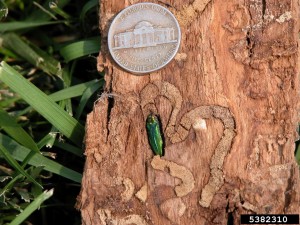Emerald Ash Borer
The emerald ash borer (Agrilus planipennis) feeds on ash (Fraxinus spp.) trees and was first discovered in 2002 in Michigan. Since then, this Asian species has spread to nine states resulting in the death of millions of ash trees. To date, it has only been found feeding on ash trees in the US. In the summer of 2008 it was found in a park campsite in southeastern Missouri and in July of 2012 it was found in Platte county Missouri. The beetle larvae tunnels in and feeds on the vascular tissue of the tree just below the bark causing branch and crown die back. In as little as a single year their feeding may result in the death of half of the branches in a tree.
Symptoms and Diagnosis
Dead and or dying branches in the upper canopy of ash trees are generally the first sign of an infestation. Small 1/8 inch diameter, D-shaped holes may be seen in the bark where adult beetles  have emerged. When bark is removed sawdust-filled tunnels or galleries are present where the insect larvae have been feeding. ½ inch whitish larvae may be seen in the tunnels. Adult beetles are a slender, ½ to 5/8 inch-long, with bright emerald-green wing covers. Woodpeckers feeding on ash trees excavating holes to harvest the burrowing larvae can also be an indicator that an ash tree is infested.
have emerged. When bark is removed sawdust-filled tunnels or galleries are present where the insect larvae have been feeding. ½ inch whitish larvae may be seen in the tunnels. Adult beetles are a slender, ½ to 5/8 inch-long, with bright emerald-green wing covers. Woodpeckers feeding on ash trees excavating holes to harvest the burrowing larvae can also be an indicator that an ash tree is infested.
Life Cycle
The insect completes its life cycle in one year to two years. Adults begin emerging in late May or early June with their peak in late June. Adults remain active for about three to six weeks while they feed on ash foliage where they cause only minimal damage. Females mate and lay eggs on the bark surface, in cracks and crevices, or just under the outer bark of ash trees. The young larvae hatch in 2-3 weeks and tunnel beneath the bark to reach the tree’s cambium where they feed until fall. The pest overwinters as a larva. Pupation occurs in April or May. Adults emerge in late May or early June, initiating a new brood.
Integrated Pest Management Strategies
1. Keep your tree healthy. Keeping a plant healthy and growing vigorously is always good insurance and may buy you some extra time to help an infested tree, but unlike other hardwood borers, emerald ash borer will attack healthy trees.
2. Don’t transport the pest. One of the major ways this pest has spread is by people transporting firewood from place to place. An infested ash may have died and been cut up for firewood in one state or area and then someone transported it to another area. When the adults emerge they infest ash trees in the new area. Don’t transport firewood. Use only clean, local firewood.
3. Monitor your trees. Little may be done to save your tree once it is infested but by close monitoring you may be able to notify pest control agencies so your tree can be correctly removed and disposed of to help prevent the insects from spreading to other trees in your yard or neighborhood.
4. Use preventative insecticides. Once the insect has been identified in your yard or area preventative insecticidal sprays may provide some protection. There are multiple types of applications available to control this pest. Request a house call from the Tree Doctor to see which would work best for you!
5. Contact a certified arborist for advice on valuable trees. Valuable trees are probably best placed under the care of a certified arborist. They are most likely to be aware of current treatments which may require a certified applicator and can help you evaluate the cost of protection with the value of your tree.
Image Citation: Eric R. Day, Virginia Polytechnic Institute and State University, Bugwood.org
